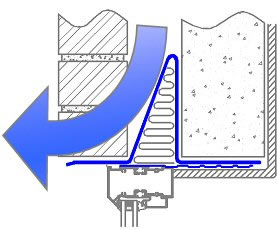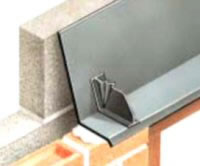Moisture Control
The outer leaf of a cavity wall is designed to be damp, shielding the inner leaf so remaining dry - the cavity prevents moisture from reaching the inner leaf. Any items that bridge this cavity should thus be designed to prevent moisture tracking across the cavity to the inner leaf, this includes lintels!
Using Cavity Lintels
The control of moisture is most applicable when lintels are used in cavity situations. The use of a cavity lintel provides a possible bridge to allow water to track across the cavity.
Lintels and DPC requirements BS 8215 - This standard governs the design and installation of damp proof courses (DPCs) in masonry buildings. It states there must be a minimum fall of 150mm across a DPC, to prevent moisture tracking inwards across a cavity.
From a corrosion perspective, all lintels except those made of stainless steel should be installed with a separate DPC above them to afford protection from moisture that would cause corrosion.
Adhesive Stop-ends
Adhesive stop ends are affixed on site to coincide with mortar joints in the masonry.
A Stopend is fixed at each end of a lintel to prevent moisture crossing over the ends of the lintel, into the cavity and onto the inside wall.
The use of stopends introduces a lintel feature that removes the possible dangers involved with water being directed into the cavity.
Stainless Steel Lintels
Lintels manufactured from stainless steel may act as a DPC in their own right so long as they have 150mm fall in the cavity from the inner down to the outer, and they have stop-ends installed. The stop-ends may be proprietary adhered stop-ends, or integrated welded stop-ends.
Lintel Materials & damp proof courses
Lintels having integral cavity tray features and meeting the surface protection criteria laid out in BS 5977 & BS EN 845-2 may be installed in outer cavity walls without a separate DPC.
Essentially, Hot dip Galvanised and Stainless Steel Lintels are the only lintels that can meet this requirement without onerous additional paint systems being applied.
A caution regarding solid external walls
Not all external walls are cavity walls, there are plenty of external solid walls! If the external wall is to have a dry inner and damp outer, then a DPC would probably be installed anyway, but there are instances of walls that are likely to be damp on both sides, and still require a lintel, such as courtyard openings etc.
In these situations, you must still install a DPC over regular pre-galvanised lintels unless they have additional paint systems applied!
The DPC in these cases is only required to protect the Lintel. This is due to the inherently low corrosion resistance of pre galvanised lintels. Many builders would omit to install DPCs in this case, so specifying stainless steel lintels avoids potential disaste

